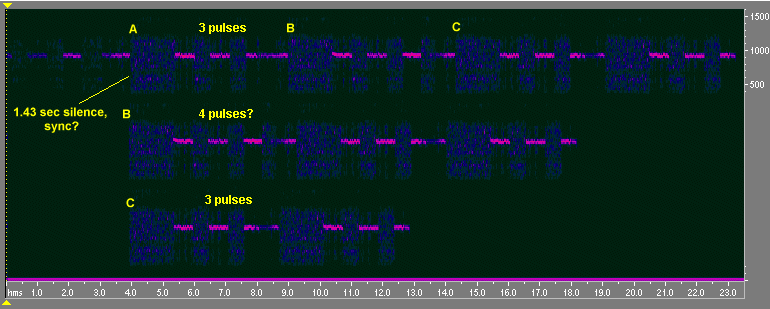
The 1K variant was launched as Sputnik-4 (or Korabl-Sputnik 1), unsuccessfully on 28 July 1960, as Sputnik-5 (or Korabl-Sputnik 2), as Sputnik-6 (or Korabl-Sputnik 3), and unsuccessfully 22 December 1960. The Sputnik-4 vehicle did not have a re-entry vehicle capable of passing through the earth's atmosphere. Therefore it was designated 1KP, P for "prostoy", i.e. simple.
All Vostok vehicles carried a short-wave telemetry transmitter operating near 20 MHz. In this article I analyze telemetry from two 1K spacecraft and the 3K version, and find that telemetry systems are of three different designs.
Sputnik-4 signals on 19.995 MHz, recorded by Dieter Oslender in Bonn, Germany in May 1960
Listen to the signal which is similar to later pulse-duration (PDM) telemetry from spacecraft in the Zenit series. The recording seems to be put together from several short segments of signals. The synchronization "purr" or pulse train consists of 24 pulses and is placed in the middle of a word interval instead of taking up most of the word interval starting at the leading edge of the word interval. This type of telemetry was not noticed again from a craft related to the Soviet manned program until the flight of Kosmos-110, a Voskhod carrying the two dogs Veterok and Ugulyok. However, the pulse-duration telemetry with synchronization "purr" was to become a standard feature of the Zenit reconnaissance satellite.
Sputnik-5 signals on 19.995 MHz, recorded by Dieter Oslender in Bonn, Germany in August 1960

The graph above shows
telemetry
from Sputnik-5. It seems that the signal can be broken down in segments
starting with a 1.43 second period of silence. I have put these
segments
on top of each other. This assumes that the 1.43 second silences are
means
of synchronization. There are three or four pulses between the sync
periods.
When listening to the signal
it sounds much like an irregular beep-beep. A longer recording would be
needed to better determine the character of this telemetry systems.
However,
clearly, this type of telemetry is different from that of Sputnik-4.
Interesting,
hmm....
Korabl Sputnik 4 (Sputnik-9) signals on 19.995 MHz, recorded by Alois DL3PD from Czech radio in 1961

Korabl-Sputnik 4 was the next-to-last test flight of Vostok before Yuri Gagarin's flight and was launched 0628:48 UT on 9 March 1961. The recording here is obtained from the web site (Homepage DD1US) of Matthias Bopp. He got it from his friend Alois DL3PD who recorded therse signals from Czekh radio. It is not absolutely certain that the recording actually comes from Sputnik-9, but let us assume that is is so. Presumably this was a recording from official sources replayed on a public broadcasting station. Of course, the signal could have come froma local ham.... Listen to the signal (mp3 file) which is very similar to the Sputnik-4 signals. The word length is again about 1.3 seconds and what we hear is actually the "off" level of the pulse-duration (PDM) telemetry.The synchronization "purr" or pulse train consists of 29 pulses (24 for Sputnik-4). Stranegly enough there are a few words that are 1.15 seconds long!
Vostok-5 beacon on 19.948 MHz, recorded by Chris van den Berg in the Netherlands, June 1963

In manned Vostok flights the shortwave beacon near 20 MHz turned out to contain simple biomedical telemetry. Initially the signal was just a CW carrier interrupted for about 0.13 sec at a rate corresponding to the heart rate. Later the interruption period was modulated by the respiration signal. The picture above shows the signals from Vostok-5. (Listen here)